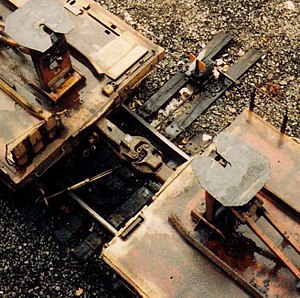Slack action

In railroading, slack action is the amount of free movement of one car before it transmits its motion to an adjoining coupled car. This free movement results from the fact that in railroad practice cars are loosely coupled, and the coupling is often combined with a shock-absorbing device, a "draft gear", which, under stress, substantially increases the free movement as the train is started or stopped. Loose coupling is necessary to enable the train to bend around curves and is an aid in starting heavy trains, since the application of the locomotive power to the train operates on each car in the train successively, and the power is thus utilized to start only one car at a time.
United Kingdom
The UK formerly used three-link couplings, which allowed a large amount of slack; these have since been replaced by buffers and chain couplers. While the couplings are held tight by buffers and shortened by a turnbuckle, other railways decided to replace them with automatic couplings, such as the Scharfenberg coupler and the Janney coupler.
See also
References
